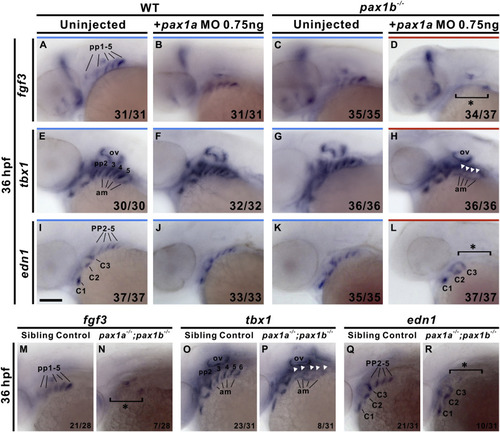
pax1a- and pax1b-deficient embryos exhibit absent fgf3, tbx1 and edn1 expression in pharyngeal pouches. Absent expression of fgf3 in pharyngeal pouches (pp) 1–5 was identified in 0.75 ng pax1a MO-injected pax1b−/− mutant embryos (D) compared to uninjected wild types (WT; A), 0.75 ng pax1a MO-injected wild types (B) or uninjected pax1b−/− mutant embryos (C) at 36 hpf. Similar absent expression of tbx1 or edn1 in posterior pharyngeal pouches 2–5 were observed in 0.75 ng pax1a MO-injected pax1b−/− mutant embryos (H, L) compared to uninjected wild types (E, I), 0.75 ng pax1a MO-injected wild types (F, J) or uninjected pax1b−/− mutant embryos (G, K) at 36 hpf. Similar defects in endodermal expression of fgf3 (N), tbx1 (P) and edn1 (R) in pharyngeal pouches were also found in pax1a−/−; pax1b−/− double mutants in contrast with sibling controls (i.e., pax1a+/−; pax1b−/− or pax1a+/+; pax1b−/−) (M, O, Q) at 36 hpf. Asterisks or arrowheads indicate absent expression. Affected embryos per total number of analyzed embryos are shown. Am, adjacent mesoderm; C, mesodermal core; ov, otic vesicle. Scale bars represent 100 μm.
|

